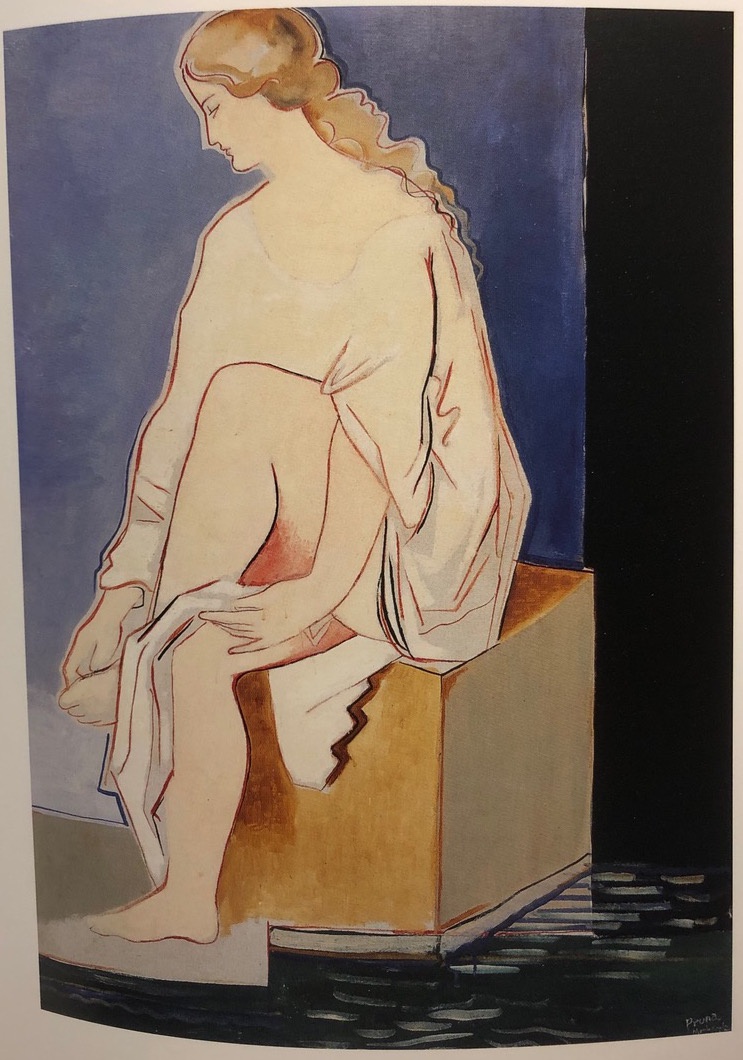-
Pere Pruna
Barcelona 1904–1997
Baigneuses
1929
Oil on canvas
117 × 89 cm
Provenance
Galerie Lucien Lefebvre-Foinet, Paris
Las Meninas, Barcelona
Exhibitions
1934 New York, Marie Sterner Gallery
The Arts Club of Chicago
1936 One of his paintings was exhibited as a Spanish contribution to the Carnegie Competition Exhibition at the Toledo Museum of Art, Toledo, Ohio.
Museums
Biblioteca-Museu Víctor Balaguer, Vilanova i la Geltrú
Museu de Montserrat
Museu d’Art de Sabadell
Museu de l’Empordà, Figueres
Awards
1929 - Second medal, Carnegie Institute, Pittsburgh, Pennsylvania.
1938 - Participates at the Venice Biennale.
1965 - Premi Ciutat de Barcelona
1968 - Clau de la Ciutat de Barcelona
Member of the Reial Acadèmia de Belles Arts de Sant Jordi
Exhibitions
1934 New York, Marie Sterner Gallery
The Arts Club of Chicago
1936 One of his paintings was exhibited as a Spanish contribution to the Carnegie Competition Exhibition at the Toledo Museum of Art, Toledo, Ohio.
Pere Pruna Ocerans was born in Barcelona. At only thirteen years old, he participated in an exhibition at the Areñas Galleries in Barcelona, a show presented by Jaume Brossa and Josep Maria Junoy. His learning as a painter was slow, but marked by his decision to become a renowned artist. In the beginning, he worked in Manuel Valentí's jewelry workshop, and attended classes taught by the painter Francesc Labarta at the Municipal School of Art. At the same time, it was common to find him in workshops of renowned artists, such as Ricard Canals and Sebastià Junyer.
From the very beginning, Pruna was adventurous with his artistic language. He was interested in Matisse, Pissarro, Derain, and, above all else, Cézanne; his admiration for the master of Aix lasted a lifetime.
Not without financial difficulties, in 1921 Pere Pruna moved to Paris. One of his first visits in the city was to Picasso, with whom he began a long friendship. Seeing Pruna's works, Picasso did not hesitate to send them to his dealers, especially André Lebel, director of the Galerie Percier. Lebel agreed to represent the Catalan painter, and was responsible for the success and recognition Pruna received in the early years of the 1920s. His first exhibition in Paris, at the Galerie Percier, was in 1924.
In his early Parisian stage, Pruna's work reflects the influence of Picasso, both in the style of his paintings and in their subject matter. From this moment, paintings such as Composition with Figures (1921), Woman with a Mantilla (1924) or El Arlequín (1926) stand out.
Josep Pla, one of the great Catalan prose writers of the 20th century, was right when he wrote: “Everyone says that Pruna imitates Picasso. It would be more accurate to say that Picasso and Pruna share the same aim. It has been said that Picasso is the last Italian painter. Actually, he is the penultimate one, because the last one is Pruna.” In fact, his naked ladies on the beach connect with the neoclassical Picasso who in the 1920s found a painting in keeping with the new times, with the return to order idealised by Jean Cocteau. The female nude, Greek sculpture, nudism, the new cult of sport and Poussin were the ingredients with which, after Cubism, Picasso created a new ground-breaking artefact.
It was then that he was commissioned by the Russian dancer Serge de Diaghilev to design the sets and costumes for his shows, just as Picasso and Sert had done years before. Among the scenographies signed by Pruna is Les matelots, La Pastoral, Pucinella, Maximiliano or Danseur. This theatrical collaboration, which continued until 1940, made his work have more impact, and became an artist highly appreciated by collectors in England, Italy and the United States.
In the late 1920s, Pruna needed to change direction. From 1930 onwards, his work built up prestige among the Catalan bourgeoisie. He frequented Barcelona more and more and exhibited regularly in galleries in the city. The outbreak of the Civil War surprised him in Barcelona, where he was with his family. In 1937, he decided to return to Spain, and joined the Francoist forces. When the war ended, he stayed between Sitges and Montserrat, places that were connected to his artistic personality, which reaffirmed his teaching.
After the end of the Second World War, Pruna tried to return to Paris, but the city received him coldly. His companions were artists in favor of the Republic, like Picasso. They felt betrayed by Pruna, who aligned himself with the Francoist side during the Civil War.

Pere Pruna, Woman coming out of the bath, 1925.
Madrid, private collection.

Pere Pruna, Seated women, 1923.
Fons d’Art de la Caixa de Terrassa
